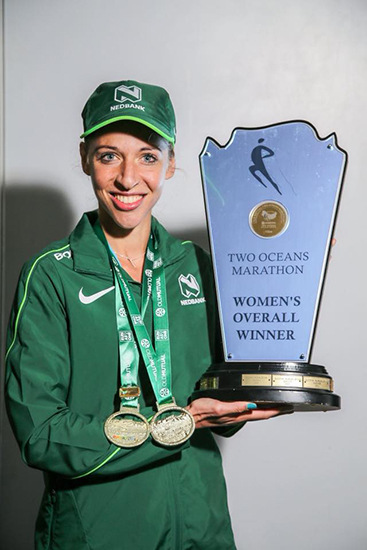Latest News Archive
Please select Category, Year, and then Month to display items
18 April 2018
Photo Facebook
 Gerda Steyn, former Kovsie student and winner of the Two Oceans ultramarathon this year, with her trophy.
Gerda Steyn, former Kovsie student and winner of the Two Oceans ultramarathon this year, with her trophy.
Gerda Steyn, female winner of this year’s Two Oceans ultramarathon, says her life has changed for the better in a very short time.
The former Kovsie received an invitation to a world-renowned marathon at the end of the year. She may not reveal the details yet.
Steyn, who studied Quantity Surveying and Construction Management at the University of the Free State (UFS) between 2009 and 2012, was just the third South African to win the Two Oceans since 1994. Her time of 3:39:31 was the second-best in the past seven years. For many she was a surprise winner because she didn’t compete last year and only managed a 14th place in 2016.
“Things really took off since the race (in Cape Town at the end of March). I received a lot of exposure. People say you must try and win the race, but they don’t tell you what will happen after that with all the media attention.
“My next goal is the Comrades for which I started training in the third week of April. I will only decide on my specific goals for the race two weeks beforehand.” She obtained a fourth place last year.
According to Steyn, who is a full-time athlete, she only did a couple of cross country races while she was studying.
“I played a bit of soccer and hockey for my hostel (Soetdoring). I have very fond memories from my university days. A couple of our hostel friends had a reunion after the race in Cape Town and had reason to have a big party.”
Mathematical methods used to detect and classify breast cancer masses
2016-08-10
 Examples of Acho’s breast mass
Examples of Acho’s breast mass
segmentation identification
Breast cancer is the leading cause of female mortality in developing countries. According to the World Health Organization (WHO), the low survival rates in developing countries are mainly due to the lack of early detection and adequate diagnosis programs.
Seeing the picture more clearly
Susan Acho from the University of the Free State’s Department of Medical Physics, breast cancer research focuses on using mathematical methods to delineate and classify breast masses. Advancements in medical research have led to remarkable progress in breast cancer detection, however, according to Acho, the methods of diagnosis currently available commercially, lack a detailed finesse in accurately identifying the boundaries of breast mass lesions.
Inspiration drawn from pioneer
Drawing inspiration from the Mammography Computer Aided Diagnosis Development and Implementation (CAADI) project, which was the brainchild Prof William Rae, Head of the department of Medical Physics, Acho’s MMedSc thesis titled ‘Segmentation and Quantitative Characterisation of Breast Masses Imaged using Digital Mammography’ investigates classical segmentation algorithms, texture features and classification of breast masses in mammography. It is a rare research topic in South Africa.
Characterisation of breast masses, involves delineating and analysing the breast mass region on a mammogram in order to determine its shape, margin and texture composition. Computer-aided diagnosis (CAD) program detects the outline of the mass lesion, and uses this information together with its texture features to determine the clinical traits of the mass. CAD programs mark suspicious areas for second look or areas on a mammogram that the radiologist might have overlooked. It can act as an independent double reader of a mammogram in institutions where there is a shortage of trained mammogram readers.
Light at the end of the tunnel
Breast cancer is one of the most common malignancies among females in South Africa. “The challenge is being able to apply these mathematical methods in the medical field to help find solutions to specific medical problems, and that’s what I hope my research will do,” she says.
By using mathematics, physics and digital imaging to understand breast masses on mammograms, her research bridges the gap between these fields to provide algorithms which are applicable in medical image interpretation.